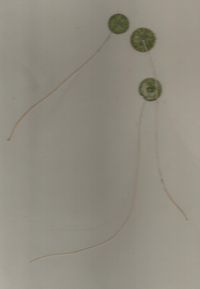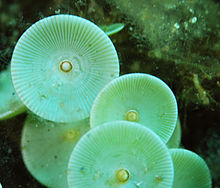- Acetabularia
-
Acetabularia Scientific classification Domain: Eukaryota Kingdom: Plantae Division: Chlorophyta Class: Ulvophyceae Order: Dasycladales Family: Polyphysaceae Genus: Acetabularia
Lamouroux, 1812[1]Species - A. acetabulum (A. mediterranea)
- A. antillana
- A. calyculus
- A. crenulata
- A. dentata
- A. farlowii
- A. kilneri
- A. major
- A. myriospora
- A. peniculus
- A. ryukyuensis
- A. schenkii
- A. toxasii
Acetabularia is a genus of green algae, specifically of the Polyphysaceae family,[2] Typically found in subtropical waters, Acetabularia is a single-celled organism, but gigantic in size and complex in form, making it an excellent model organism for studying cell biology.[3] In form, the mature Acetabularia resembles the round leaves of a nasturtium, being 0.5 to 10 cm tall and having three anatomical parts: a bottom rhizoid that resembles a set of short roots; a long stalk in the middle; and a top umbrella of branches that may fuse into a cap. The single nucleus of Acetabularia is located in the rhizoid, and allows the cell to regenerate completely if its cap is removed. The caps of two Acetabularia may also be exchanged, even from two different species.[citation needed]
Acetabularia is most famous from the experiments of Joachim Hämmerling in the 1930s-1950s, which demonstrated that its genetic information is contained in the nucleus.[4] This was the first demonstration that genes are encoded by DNA in eukaryotes; earlier studies by Oswald Avery and others had shown that this was true for prokaryotes. Hämmerling exchanged the caps from two species, A. mediterranea and A. crenulata. The caps of these species are different in form; however, after exchange, the caps gradually changed from their original form to that typical of its base, where the nucleus is located. In another experiment, the addition of a nucleus from another species into a single intact Acetabularia produced a hybrid cap, showing that both nuclei are influencing the form of the cap.[citation needed]
Acetabularia are among the largest single-celled organisms, having also a remarkably large nucleus. During sexual reproduction, the nucleus undergoes multiple rounds of mitosis, forming many daughter nuclei all within one nuclear membrane. These nuclei undergo meiosis and are transported to the tips of the branches, the sporangia, where they are released as gametes.[5]
The name, Acetabularia, derives from the Latin word acetabulum, a broad, shallow cup used for dipping bread; the upturned cap of Acetabularia resembles such a cup. For this reason, it is also sometimes called mermaid's wineglass.[6]
Contents
Anatomy and life cycle
Acetabularia has three basic parts: its rhizoid, a short set of root-like appendages that contain the nucleus and anchor the cell to fissures in a substrate; its median stalk, which accounts for most of its length; and its apex, where its cap forms. There are usually several whorls of hair-like appendages close to the apex.[citation needed]
Morphogenesis
Although a single cell, Acetabularia exhibits a remarkably complex shape and has therefore long been a model organism for studying gene expression and morphogenesis. It seems to transport messenger RNA molecules (in an inactive riboprotein form) from the nucleus to its apical tips, where they are translated into proteins. These molecules may be activated by proteolysis of their protein carrier molecules, but this has not been verified as yet.[citation needed]
Internal chemical gradients
In addition to its gradient in specific mRNA molecules, Acetabularia exhibits concentration gradients in several types of molecules, such as ascorbic acid.[citation needed]
Circadian rhythms
Acetabularia is often used to study circadian rhythms.[citation needed]
References
- ^ Lamouroux JVF (1812). "Extrait d'un mémoire sur la classification des Polypiers coralligènes non entièrement pierreux". Nouveaux Bulletin des Sciences, par la Société Philomathique de Paris 3: 181–188.
- ^ Guiry, M.D. & Guiry, G.M. (2007). "Genus: Acetabularia taxonomy browser". AlgaeBase version 4.2 World-wide electronic publication, National University of Ireland, Galway. http://www.algaebase.org/browse/taxonomy/?id=8297. Retrieved 2007-09-27.
- ^ Mandoli, DF (1998). "Elaboration of Body Plan and Phase Change during Development of Acetabularia: How Is the Complex Architecture of a Giant Unicell Built?". Annual Review of Plant Physiology and Plant Molecular Biology 49: 173–198. doi:10.1146/annurev.arplant.49.1.173. PMID 15012232.
- ^ Hämmerling, J (1953). "Nucleo-cytoplasmic relationships in the development of Acetabularia". J. Intern. Rev. Cytol.. International Review of Cytology 2: 475–498. doi:10.1016/S0074-7696(08)61042-6. ISBN 9780123643025.
- ^ Shihira-Ishikawa, I (1984). "Chromosome behavior in the primary nucleus of Acetabularia calyculus as revealed by epifluorescent microscopy". Protoplasma 122: 27–34. doi:10.1007/BF01279434.
- ^ Lee, Robert E. (1999). Phycology. Cambridge, [England]: Cambridge University Press. pp. 217. ISBN 978-0-521-63883-8.
Further reading
- Serio, D., Alongi, G., Catra, M., Cormaci, M. & Furnari, G. (2006). Changes in the benthic algal flora of Linosa Island (Straits of Sicily, Mediterranean Sea). Botanica Marina 49: 135-144.
- Berger, S. & Liddle. L.B. (2003). The life cycle of Acetabularia (Dasycladales, Chlorophyta): textbook accounts are wrong (Commentary). Phycologia 42(2): 204-207, 3 figs.
- Berger, S., Fettweiss, U., Gleissberg, S., Liddle, L.B., Richter, U., Sawitsky, H. & Zuccarello, G.C. (2003). 18S rDNA phylogeny and evaluation of cap development in Polyphysaceae (formerly Acetabulariaceae; Dasyladales, Chlorophyta). Phycologia 42: 506-561.
- Bonotto S (1994). "Developmental biology of Acetabularia". J. Mar. Biol. Ass. U.K. 74: 93–106. doi:10.1017/S0025315400035694.
- Berger S, de Groot E, Heuhaus G, Schweiger M (1987). "Acetabularia: a giant single cell organism with valuable advantages for cell biology". European Journal of Cell Biology 44: 349–370.
- Puiseux-Dao S (1970). Acetabularia and Cell Biology. New York: Springer Verlag. ISBN 0236177389.
- Schweiger H? (1969). "Cell biology of Acetabularia". Current Topics in Microbiology and Immunology 50: 1–36.
Sundry references
- Cinelli, F. (1979). Acetabularia acetabulum (L.) Silva, Acetabularia parvula Solms-Laubach and Dasycladus vermicularis (Scopoli) Krasser (Chlorophyta, Dasycladales): ecology and distribution in the Mediterranean Sea.. In: Developmental Biology of Acetabularia. (Bonotto, S., Kefeli, V. & Puiseux-Dao, S. Eds), pp. 3–14. Amsterdam: Elsevier North Holland Biomedical Press.
- Cooper, J.J. & Mandoli, D.F. (1999). Physiological factors that aid differentiation of zygotes and early juveniles of Acetabularia acetabulum (Chlorophyta). Journal of Phycology 35: 143-151, 9 figs.
- Dazy, A. C., Borghi, H., Durand, M. & Puiseux-Dao, S. (1984). The effects of blue and red light on the transcellular electric potential, cytoplasmic streaming and rRNA transport in Acetabularia acetabulum. Proceedings of the International Seaweed Symposium 11: 193-197.
- Hunt, B.E. & Mandoli, D.F. (1996). A new, artificial seawater that facilitates growth of large numbers of cells of Acetabularia acetabulum (Chlorophyta) and reduces the labor inherent in cell culture. Journal of Phycology 32: 483-495, 6 figs, 3 tables.
- Kingsley, R.J., Van Gilder, R., LeGeros, R.Z. & Watabe, N. (2003). Multimineral calcareous deposits in the marine alga Acetabularia acetabulum (Chlorophyta; Dasycladaceae). Journal of Phycology 39: 937-947.
- Kratz, R.F., Young, P.A. & Mandoli, D.F. (1998). Timing and light regulation of apical morphogenesis during reproductive development in wild-type populations of Acetabularia acetabulum (Chlorophyceae). Journal of Phycology 34: 138-146, 6 figs, 2 tables.
- Lüttke, A. (1988). The lack of chloroplast DNA in Acetabularia mediterranea (acetabulum) (Chlorophyceae): A reinvestigation. Journal of Phycology 24: 173-180, 12 figs.
- Mandoli, D.F., Wexler, A., Teschmacher, J. & Zukowski, A. (1995). Note: Brief incubation of gametangia-bearing caps in antibiotics eliminates branching in progeny of Acetabularia acetabulum (Chlorophyta). Journal of Phycology 31: 844-848, 4 figs, 3 tables.
- Menzel, D. (1981). Development and fine structure of plugs in the cap rays of Acetabularia acetabulum (mediterranea) (L.) Silva (Dasycladales). Phycologia 20: 56-64, 21 figs.
- Nishimura, N.J. & Mandoli, D.F. (1992). Population analysis of reproductive cell structures of Acetabularia acetabulum (Chlorophyta). Phycologia 31: 351-358, 9 figs, 2 tables.
- Nishimura, N.J. & Mandoli, D.F. (1992). Vegetative growth of Acetabularia acetabulum (Chlorophyta): structural evidence for juvenile and adult phases in development. Journal of Phycology 28: 669-677, 7 figs.
- Zeller, A. & Mandoli, D.F. (1993). Growth of Acetabularia acetabulum (Dasycladales, Chlorophyta) on solid substrata at specific cell densities. Phycologia 32: 136-142
External links
- www.accessexcellence.org
- Berger, Sigrid (2006).- Photo-Atlas of living Dasycladales.- ISBN 2-916733-01-9, Carnets de Géologie, Brest, Book / Livre 2006/02 (CG2006_BOOK_02), 348 p., 1 fig., 332 micrographs.
- UTEX culture collection of algae, at the University of Texas at Austin
- CCAP: Culture Collections of Algae and Protozoa
Scientific references
- PubMed references for Acetabularia
- PubMed Central references for Acetabularia
- Google Scholar references for Acetabularia
Scientific databases
Categories:- Algae genera
- Ulvophyceae
Wikimedia Foundation. 2010.


